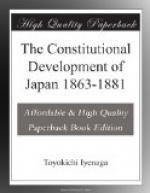Ii. Another tributary stream which helped to swell the tide flowing toward the Emperor was the revival of Shintoism. The revival of learning is sure to be followed by the revival of religion. This is shown in the history of the Reformation in Europe, which was preceded by the revival of learning. Since the expulsion of Christianity from Japan in the sixteenth century, which was effected more from political than religious motives, laissez-faire was the steadfast policy of the Japanese rulers toward religious matters. The founder of the Tokugawa dynasty had laid down in his “Legacy” the policy to be pursued by his descendants. “Now any one of the people,” says Iyeyasu, “can adhere to which (religion) he pleases (except the Christian); and there must be no wrangling among sects to the disturbance of the peace of the Empire.” Thus while the people in the West, who worshipped the Prince of Peace, in his abused name were cutting each other’s throat, destroying each other’s property, torturing and proselyting by rack and flames, the islanders on the West Pacific coast were enjoying complete religious toleration. Three religions—Shintoism, Buddhism, and Confucianism—lived together in peace. In such a state of unrestricted competition among various religions, the universal law of the survival of the fittest acts freely. Buddhism was the fittest and became the predominant religion. Shintoism was the weakest and sank into helpless desuetude. But with the revival of learning, as Kojiki and other ancient literature were studied with assiduity, Shintoism began to revive. Its cause found worthy defenders in Motoori and Hirata. They are among the greatest Shintoists Japan has ever seen.
Now, according to Shintoism, Japan is a holy land. It was made by the gods, whose lineal descendant is the Emperor. Hence he must be revered and worshipped as a god. This is the substance of Shintoism. The political bearing of such a doctrine upon the then existing status of the country is apparent. The Emperor, who is a god, the fountain of all virtue, honor, and authority, is now a prisoner at the court of Kioto, under the iron hand of the Tokugawa Shoguns. This state of impiety and irreverence can never be tolerated by the devout Shintoists. The Shogun must be dethroned and the Emperor raised to power. Here the line of arguments of the Shintoists meets with that of the scholars we have noted above. Thus both scholars and Shintoists have converted themselves into politicians who have at heart the restoration of the Emperor.




